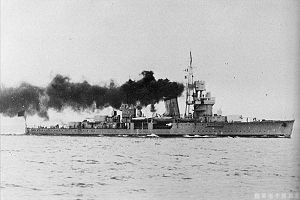- Chinese cruiser Ping Hai
-

Chinese cruiser Ping Hai in 1936Career (Republic of China) 
Name: Ping Hai Builder: Kiangnan Dock and Engineering Works, Shanghai, China Laid down: June 28, 1931 Launched: September 28, 1935 Completed: June 18, 1936 Fate: sunk September 23, 1937 by Japanese Aircraft; subsequently salvaged by Japanese to become Yasoshima General characteristics Type: Light cruiser Displacement: 2,448 t (2,409 long tons) Length: 360 ft (110 m) Beam: 39 ft (12 m) Draught: 13 ft (4.0 m) Propulsion: Two-shaft Reciprocating Engines; 1 oil-fired and 4 coal-fired boilers; 7,488 hp (5,584 kW) Speed: 21 knots (24 mph; 39 km/h) Range: 5,000 nmi (9,300 km) at 12 kn (14 mph; 22 km/h) Complement: 361 Armament: • 6 × 140 mm (6 in) guns
• 3 × 76 mm (3 in) AA guns
• 4 × 57 mm (2 in) AA guns
• 4 × machine guns
• 4 × 533 mm (21 in) torpedo tubes
• 9 × depth chargesThe Ping Hai (traditional Chinese: 平海 "Amicable Seas") was a light cruiser in the Chinese fleet before World War II and the second ship of the Ning Hai class cruiser. It was laid down in China to the specifications supplied by the Japanese, and Japanese advisors were hired to oversee the construction. Compared to its sister ship Ning Hai, it had a lower-output powerplant and lacked seaplane facilities. Its anti-aircraft armament was also different from that of its sister.
The progress of its construction was affected by the Mukden Incident (18 September 1931) and the January 28 Incident (28 January – 3 March 1932). Disruption of parts supply and non-cooperation of Japanese advisors delayed its launch date from the originally planned 10 October 1933 to 28 September 1935. Blocked delivery of originally-specified anti-aircraft weapons meant that equivalent replacements of those weapons had to be bought via Germany. When it was completed in 1936, official outbreak of war was barely a year away.
Service record
Ping Hai served as the flagship of the Republic of China Navy since April 1937.
As one of the most powerful surface combatants within the ROCN, Ping Hai was subjected to aerial attacks by the Imperial Japanese Navy since the Battle of Shanghai, but it was not until September 23, during the Japanese assault on the Kiangyin Fortress (which guarded the segment of Yangtze River near Nanking), for Ping Hai to finally succumb with its sistership to airstrikes launched from both carrier Kaga and airfields around occupied Shanghai.
It was then re-floated by the Japanese in 1938 as sunken ships would not be as badly corroded by river water as they would be by sea water. Originally it was to be transferred to the Collaborationist navy under Wang Jing-Wei, but the Japanese elected to seize it instead and outfitted it first as a barracks hulk and ultimately as escort ship Yasoshima on 10 June 1944.
External links
- http://www.globalsecurity.org/military/world/japan/exchina-cl.htm
- http://big5.chinabroadcast.cn/gate/big5/gb.cri.cn/3821/2004/08/26/151@280506.htm
Ning Hai · Ping Hai
List of cruisers of the Republic of China Navy Categories:- Ning Hai class cruisers
- Ships built in China
- 1931 ships
- Second Sino-Japanese War cruisers of China
- Ships sunk by aircraft
- World War II cruisers of Japan
- Naval ship stubs
Wikimedia Foundation. 2010.
